The Microsoft Surface Book 3 (15-Inch) Review: A Refreshing Dip Into Ice Lake
by Brett Howse on June 3, 2020 9:00 AM ESTDisplay
Microsoft committed to display quality in a big way back with the launch of the original Surface Book in 2015, and have continued to deliver some of the best displays in the PC industry. The Surface Book 3 offers the same display choices as the previous generation, with the 13.5-inch getting a 3000x2000 panel, and the 15-inch offering a 3240x2160 panel. The Surface Book team has also shown the importance of not only strong color accuracy and high resolution, but also high contrast ratios as well.
When Microsoft bucked the trend of 16:9 displays on Windows-based laptops, it was a big improvement to the tablet experience, since a 16:9 device works very poorly as a handheld display. The tablet capabilities have been promoted less over the years, but the 3:2 aspect they chose also tends to work very well for productivity tasks on a laptop computer. The industry took note, and we have all benefited, and more and more devices are shipping with taller aspect ratios, whether it be 3:2, or 16:10.
The one area where the 3:2 aspect can be a problem though is gaming, with some games counting on 16:9 aspect ratios. Thanks to the nearly seven million pixels on this panel, gaming at the native resolution, even with the GTX 1660 Ti, is not always possible, so having to fall back to 1920x1080 can be a hit or miss proposition. It can also cause some letterboxing when watching 16:9 video, but unless that is all you are planning on doing on the Surface Book, it likely won’t be an issue.
The seven million pixels translates into 260 pixels per inch, making the display much sharper than the Surface Laptop 3 15 (which is right at 200 pixels per inch), so text is very crisp.
Microsoft continues to include both an sRGB color mode, adhering very strictly to the sRGB gamut, as well as an “Enhanced” display mode, which adds a bit more punch to the colors. The only device Microsoft currently offers a wider-than-sRGB gamut is the Surface Studio desktop, which offers not only sRGB but also DCI-P3 and P3-D65 gamut options.
This is a bit of a touchy subject on Windows-based PCs though. Other manufacturers are adding wider gamut support such as P3-D65 or Adobe RGB, as well as HDR capabilities, so it may seem like a negative to not see this on Microsoft’s flagship notebook, but the fact of the matter is that the experience of using wide gamuts and HDR in Windows 10 is poor, to say the least. Windows has never offered a system-wide color management system, instead leaving the use of CMS up to individual applications, which as you can likely guess, more often than not do not leverage it. The Windows Shell itself has no color management built-in, so running a wide-gamut display will alter the colors of the desktop, Start Menu, and more. Until Windows fixes the mess that is color, it is probably the correct decision to stick with the “normal” gamut of sRGB even on a notebook such as this.
But, if there is to be any movement here, it feels like Microsoft is finally set up for success. In February, Panos Panay, who was the head of the Surface team, was tasked with heading the new Windows and Device team at Microsoft, so he is charge of not only Surface but also Windows Client. The Surface team has already brought about change in Windows, adding features that the Surface team required for their products directly into Windows, so if there was ever a time to see Microsoft take color management seriously, it would be now.
To see how the Surface Book 3 compares to its predecessors, we tested the display properties with an X-Rite i1Display Pro colorimeter for brightness and contrast measurements, and the X-Rite i1Pro2 spectrophotometer for color accuracy readings. As always, we thank Portrait Displays for the CalMAN software suite.
Brightness and Contrast
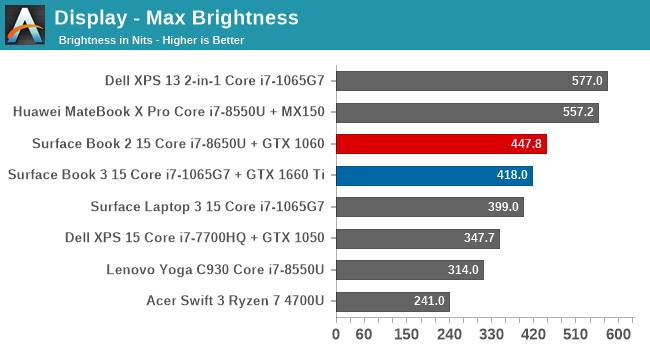
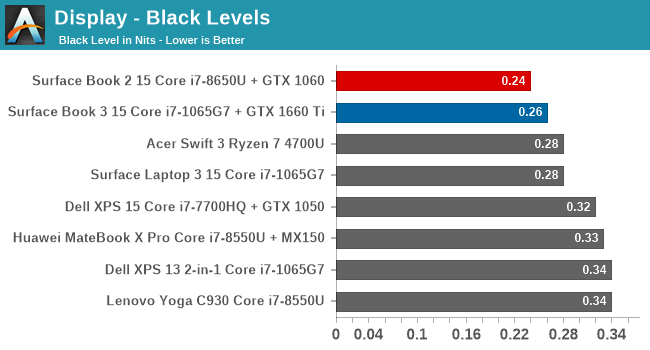
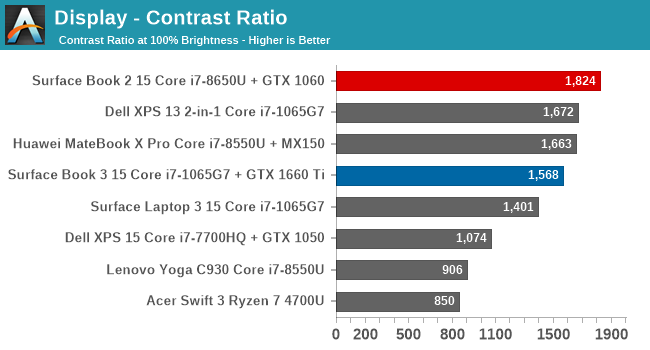
Despite the high-resolution panel, the Surface Book 3 achieves a solid 420 nits of brightness, and continues to offer the strong black levels we are accustomed to on this series of notebooks. It does not quite match the exceptional panel we had tested on the Surface Book 2, but it is still strong.
Grayscale
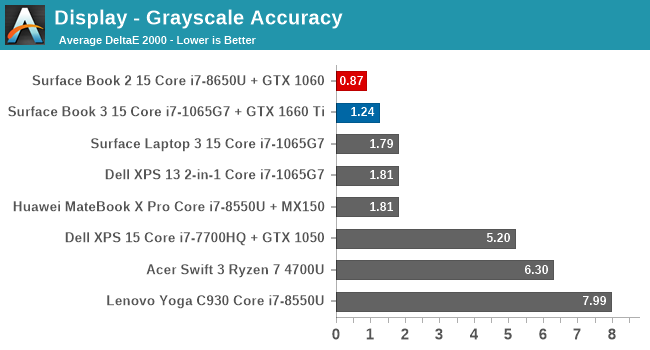
As usual, the Surface team’s calibration has done an excellent job, with very consistent RGB levels across the entire range, and error levels well under the 3.0 target. Gamma is slightly low at the dark end of the range, but manages to come in very close to the 2.2 target.
Gamut
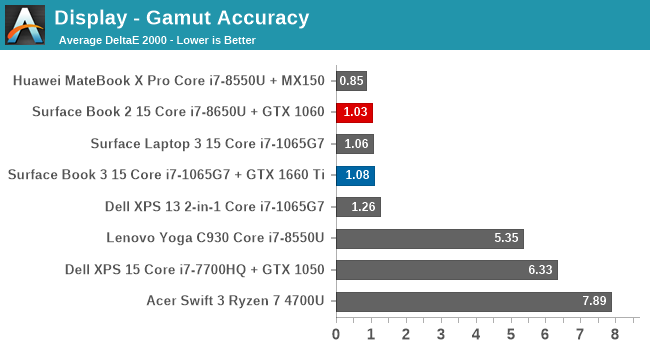
The Surface Book 3 achieves nearly perfect sRGB gamut coverage, with the blue levels only slightly off.
Saturation
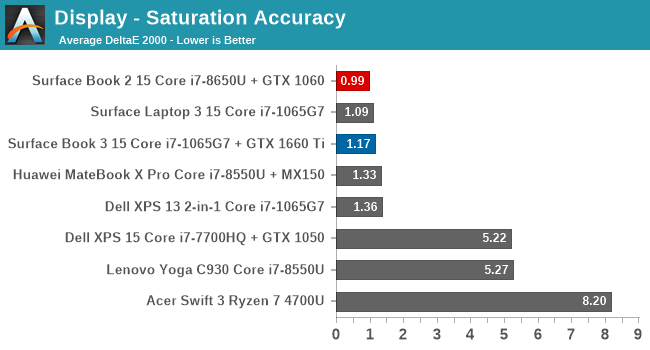
The saturation sweep tests the same primary and secondary color axis, but at 4-bit steps rather than at the 100% levels, and the Surface Book 3 delivers very strong results across the entire range. Red and Cyan are slightly off, but it would be difficult to detect with the naked eye.
Gretag Macbeth
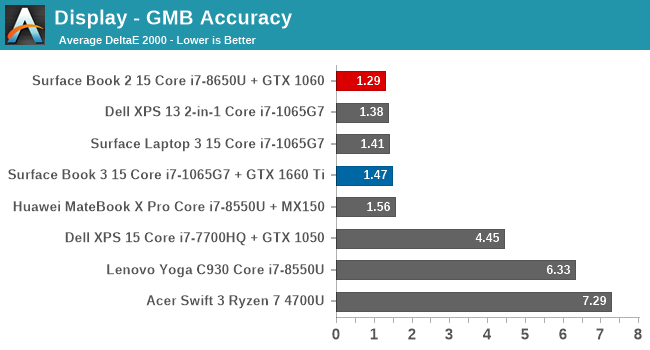
Our final test is the Gretag Macbeth, which not only tests the primary and secondary colors, but also many colors in-between, including the all-important skin tones. With an average error level of 1.46, the Surface Book 3 performs very well, and it achieves that without a single color having an error level above 3.0.
ColorChecker
Finally, this relative ColorChecker test shows the expected color on the bottom, and the achieved color on the top of the image. It is relative though because any error in your own monitor would be displayed here. But as we are used to on Surface devices, the display accuracy is fantastic.
Display conclusion
The Surface Book 3 continues to deliver one of the best display experiences in the PC space. The combination of high pixels-per-inch, strong contrast, and top-tier color accuracy continue to place the Surface Book 3 ahead of most displays on the market.
The lack of wider-gamut and HDR support is noticeable though on a spec sheet, even if the overall customer experience may not be as good as a proper sRGB display. We can hope that with Surface and Windows under the same leadership now, this may finally be addressed, but as we’ve seen with the High DPI changes in Windows 10, that change is not always easy or pain-free.



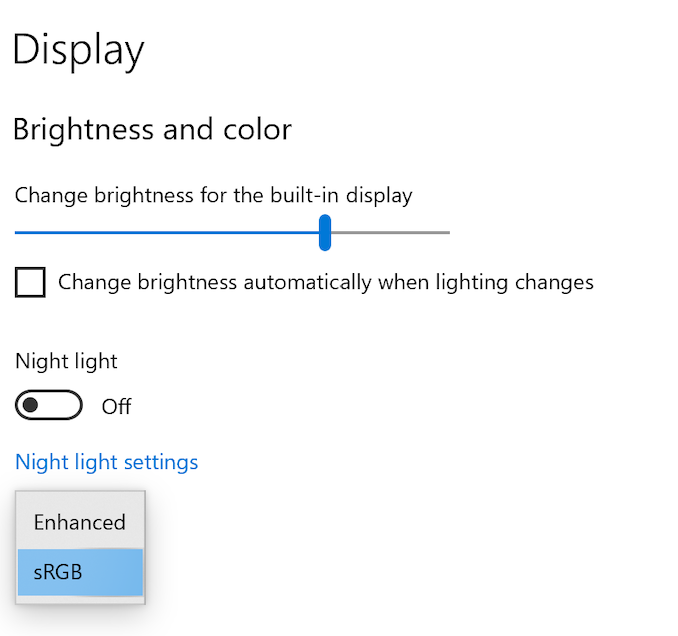













125 Comments
View All Comments
Aisalem - Wednesday, June 3, 2020 - link
Did you ever try to use Surface Book outdoors?I can only say that as soon as the temp is over 90F (around 30C) my Book 2 will overheat and lock CPU at 800MHz, it's simply piece of junk at that time.
As much as I like it when used in cold office I will never buy another MS product due to that and also luck of proper servicing.
damianrobertjones - Wednesday, June 3, 2020 - link
Good luck with any oem as they've ALL had issues at one point in time.kenjiwing - Wednesday, June 3, 2020 - link
Does anyone know if the surface book 3 can drive two 4k displays at 60hz? The 2 could not because it used the internal intel chip instead of the nvidia one for external displays.timecop1818 - Wednesday, June 3, 2020 - link
i7-1065G7 supports DisplayPort 1.4, so theoretically with a type-c to dual displayport converter/MST hub you should be able to do 2x 4K@60. See https://dancharblog.wordpress.com/2019/10/10/dual-... for required bits.kenjiwing - Wednesday, June 3, 2020 - link
Thank you!FXi - Wednesday, June 3, 2020 - link
Just be wary because the SB2 cannot drive any external display using the 1060 GPU. Since that was not listed as an improvement of the SB3 you'll want to check carefully. You may be fine using the integrated Intel GPU to drive 2 4K displays or you may not. But no one reviewing has yet checked to see if the 1660 can drive any external connector (USB C or via the dock).kenjiwing - Thursday, June 4, 2020 - link
Well shitdamianrobertjones - Wednesday, June 3, 2020 - link
A full SD card slot would have been AMAZING! (Well... better, at least).amb9800 - Wednesday, June 3, 2020 - link
It has a full-sized SD card slot...ikjadoon - Wednesday, June 3, 2020 - link
Surface Book 3 (Anandtech, 2020):"Although the Surface Book 3 can ship with the fastest SSD Microsoft has ever put in a notebook, that was not the case for the review unit, which was actually slower than the 256 GB SSD in the Surface Laptop 3."
Surface Book (Anandtech, 2015):
"On a premium device like the Surface Book, I would expect only the best, and while the drive may meet their internal performance levels, a cacheless TLC based SSD in a premium device is not necessary."
Storage really cannot be that complex a decision. There are, at most, 5-6 OEM SSDs used on high-end premium notebooks.
Glad to see platform & internal improvements and a big thank you to Microsoft for outfitting these with at least decent webcams. For the price, though:
-- no TB3 is a sore spot (Microsoft Docks are obscenely priced and come with no smaller options...not to mention how buggy they have been)
-- a *single* USB type-C port is egregious in a premium 2020 15" notebook
-- that slow charging is painful for this "executives on the move" niche market (0-80% in an hour: curious they give the one-hour charging speed instead of 30 minutes...)
Are these nitpicks? Sure. But for a device that claims to "serve the high-end market", Microsoft continuously fails to read the room in a few crucial ways.
What else can do you, besides pity Panos Panay's Steve Jobs routine?